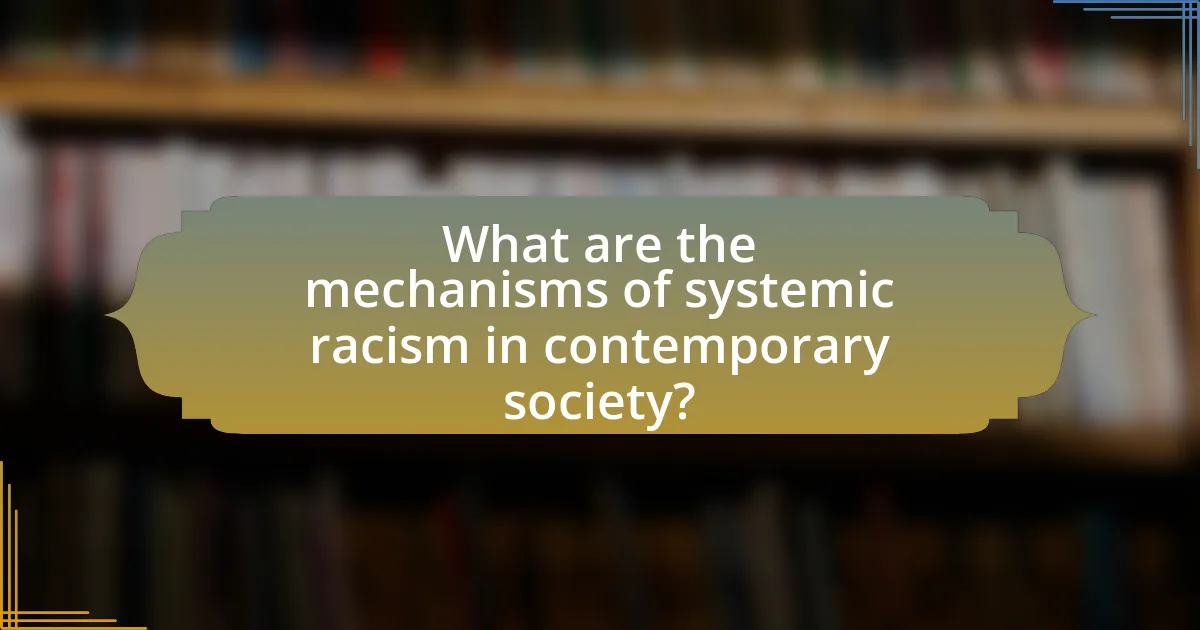The article examines the historical roots of systemic racism in the United States, tracing its origins to the institution of slavery established in the 17th century. It discusses how laws such as the Slave Codes and Jim Crow laws institutionalized racial hierarchies and discrimination, leading to enduring social and economic disparities. Key events, including the Civil War and the Civil Rights Movement, are highlighted to illustrate the evolution of systemic racism, while contemporary manifestations in education, employment, and the criminal justice system are analyzed. The article concludes with strategies for addressing systemic racism through policy reform, education, and community engagement.

What are the Historical Roots of Systemic Racism in the United States?
The historical roots of systemic racism in the United States stem from the institution of slavery, which began in the early 17th century and established a racial hierarchy that privileged white individuals over Black individuals. This system was codified through laws such as the Slave Codes, which restricted the rights of enslaved people and reinforced their status as property. Following the Civil War, the implementation of Jim Crow laws institutionalized racial segregation and discrimination, further entrenching systemic racism in various aspects of American life, including education, housing, and employment. The legacy of these laws and practices continues to influence social and economic disparities today, as evidenced by ongoing racial inequalities in wealth, health, and criminal justice outcomes.
How did systemic racism develop in early American history?
Systemic racism in early American history developed through the establishment of laws and practices that institutionalized racial discrimination, particularly against African slaves and Indigenous peoples. The introduction of slavery in the 17th century, codified by laws such as the Virginia Slave Codes of 1705, created a legal framework that dehumanized Black individuals and justified their exploitation. Additionally, the displacement and genocide of Native Americans were sanctioned by policies like the Indian Removal Act of 1830, which facilitated land seizure and reinforced racial hierarchies. These legal structures and societal norms entrenched racial inequalities, leading to systemic racism that persisted throughout American history.
What role did slavery play in establishing systemic racism?
Slavery was foundational in establishing systemic racism by institutionalizing racial hierarchies that dehumanized Black individuals and justified their exploitation. The transatlantic slave trade, which forcibly brought millions of Africans to the Americas, created a legal and social framework that categorized people based on race, positioning white individuals as superior and Black individuals as inferior. This framework was codified in laws that denied enslaved people basic human rights and established a system of racial discrimination that persisted long after slavery was abolished. For instance, the 1662 Virginia law that declared children of enslaved mothers would also be enslaved reinforced the notion of racial inferiority and created generational cycles of oppression. This systemic racism was further entrenched through Jim Crow laws and segregation, which perpetuated economic, social, and political inequalities based on race, demonstrating that the legacy of slavery directly contributed to the ongoing structures of systemic racism in the United States.
How did colonial laws contribute to racial discrimination?
Colonial laws institutionalized racial discrimination by codifying racial hierarchies and restricting the rights of non-white populations. For example, laws such as the Virginia Slave Codes of 1705 defined enslaved Africans as property, stripping them of legal rights and establishing a system of chattel slavery that dehumanized individuals based on race. Additionally, these laws created a legal framework that permitted and encouraged racial segregation, disenfranchisement, and unequal treatment, thereby embedding systemic racism into the social and legal fabric of colonial society. This legal foundation laid the groundwork for enduring racial inequalities that persisted long after the colonial period.
What were the key events that shaped systemic racism in the U.S.?
Key events that shaped systemic racism in the U.S. include the establishment of slavery in the 17th century, the enactment of the Jim Crow laws in the late 19th century, and the Civil Rights Movement in the 1960s. The introduction of slavery allowed for the legal and economic exploitation of African Americans, creating a foundation for systemic inequality. Jim Crow laws institutionalized racial segregation and discrimination, reinforcing social and economic disparities. The Civil Rights Movement sought to dismantle these oppressive systems, leading to significant legal changes, such as the Civil Rights Act of 1964 and the Voting Rights Act of 1965, which aimed to address and reduce systemic racism. These events collectively illustrate the historical trajectory of systemic racism in the United States.
How did the Civil War and Reconstruction impact systemic racism?
The Civil War and Reconstruction significantly entrenched systemic racism in the United States by failing to provide lasting protections for newly freed African Americans. The war ended slavery, but the Reconstruction era saw the implementation of Black Codes, which restricted the rights of Black individuals and maintained white supremacy. For instance, laws enacted in Southern states limited Black people’s ability to vote, own property, and access education, effectively perpetuating racial inequality. Additionally, the withdrawal of federal troops in 1877 led to the rise of Jim Crow laws, institutionalizing segregation and discrimination. These developments solidified systemic racism by embedding discriminatory practices into the legal and social fabric of American society.
What legislation reinforced systemic racism in the post-Reconstruction era?
The legislation that reinforced systemic racism in the post-Reconstruction era includes the Jim Crow laws. These laws, enacted in the late 19th century, mandated racial segregation in public facilities and disenfranchised African Americans through measures such as literacy tests and poll taxes. The Supreme Court’s decision in Plessy v. Ferguson (1896) upheld the constitutionality of racial segregation under the “separate but equal” doctrine, further entrenching systemic racism in American society.
How did systemic racism evolve through the 20th century?
Systemic racism evolved through the 20th century primarily through institutional policies and societal norms that perpetuated racial inequality. In the early part of the century, Jim Crow laws enforced racial segregation in the South, institutionalizing discrimination in education, employment, and public services. The Great Migration saw millions of African Americans move to northern cities, where they faced new forms of discrimination, such as redlining, which restricted access to housing and financial services based on race.
During the Civil Rights Movement of the 1950s and 1960s, systemic racism was challenged through protests and legal actions, leading to landmark legislation like the Civil Rights Act of 1964 and the Voting Rights Act of 1965, which aimed to dismantle institutional barriers. However, despite these advancements, systemic racism persisted in various forms, including mass incarceration and disparities in wealth, education, and healthcare, which continued to disadvantage communities of color.
The evolution of systemic racism throughout the century reflects a complex interplay of legal, social, and economic factors that have entrenched racial inequalities in American society.
What were the effects of Jim Crow laws on African American communities?
Jim Crow laws severely restricted the rights and freedoms of African American communities, leading to widespread social, economic, and political disenfranchisement. These laws enforced racial segregation in public facilities, schools, and transportation, which institutionalized inequality and reinforced a system of white supremacy. For instance, the Plessy v. Ferguson decision in 1896 upheld the constitutionality of racial segregation under the “separate but equal” doctrine, legitimizing discriminatory practices. Additionally, Jim Crow laws imposed barriers to voting, such as literacy tests and poll taxes, which effectively disenfranchised millions of African Americans, contributing to their marginalization in the political sphere. The cumulative effects of these laws fostered systemic poverty, limited access to quality education, and perpetuated cycles of violence and discrimination against African Americans, deeply impacting their communities for generations.
How did the Civil Rights Movement challenge systemic racism?
The Civil Rights Movement challenged systemic racism by advocating for legal and social equality for African Americans, leading to significant legislative changes. Key events, such as the Montgomery Bus Boycott in 1955 and the March on Washington in 1963, mobilized public support and highlighted the injustices faced by Black Americans. The movement resulted in landmark legislation, including the Civil Rights Act of 1964, which prohibited discrimination based on race, color, religion, sex, or national origin, and the Voting Rights Act of 1965, which aimed to eliminate barriers to voting for African Americans. These actions directly confronted and dismantled institutionalized practices that upheld systemic racism in the United States.

What are the mechanisms of systemic racism in contemporary society?
Systemic racism in contemporary society operates through various mechanisms, including institutional policies, social norms, and economic disparities. Institutional policies, such as discriminatory lending practices and biased law enforcement, perpetuate unequal access to resources and opportunities for marginalized groups. Social norms, reinforced by media representation and cultural narratives, shape perceptions and attitudes that sustain racial stereotypes and discrimination. Economic disparities manifest in wage gaps, employment discrimination, and unequal educational opportunities, which further entrench systemic inequalities. For example, a 2020 report by the Economic Policy Institute found that Black workers earn 15% less than their white counterparts, highlighting the economic impact of systemic racism. These mechanisms collectively maintain and reproduce racial inequalities in society.
How does systemic racism manifest in education and employment?
Systemic racism manifests in education and employment through unequal access to resources, discriminatory policies, and biased practices that disadvantage marginalized groups. In education, this is evident in funding disparities, where schools in predominantly minority neighborhoods receive significantly less funding than those in affluent areas, leading to poorer educational outcomes. For instance, a 2019 report by the U.S. Department of Education highlighted that schools serving mostly Black and Hispanic students received about $23 billion less than those serving predominantly white students.
In employment, systemic racism is reflected in hiring practices, wage gaps, and promotion opportunities. Research from the National Bureau of Economic Research found that job applicants with “Black-sounding” names received 50% fewer callbacks than those with “white-sounding” names, despite having identical qualifications. Additionally, the Economic Policy Institute reported that Black workers earn approximately 15% less than their white counterparts, even when controlling for education and experience. These factors illustrate how systemic racism creates barriers in both education and employment, perpetuating inequality.
What disparities exist in educational opportunities for different racial groups?
Disparities in educational opportunities for different racial groups include significant differences in funding, access to advanced coursework, and school resources. For instance, predominantly Black and Hispanic schools often receive less funding than those serving predominantly white populations, leading to inadequate facilities and fewer educational materials. According to the U.S. Department of Education, schools with higher percentages of students of color receive about $23 billion less in funding than predominantly white schools. Additionally, students from marginalized racial groups are less likely to have access to advanced placement courses and experienced teachers, which further exacerbates educational inequities. These systemic issues are rooted in historical practices such as redlining and discriminatory policies that have perpetuated segregation and inequality in education.
How does systemic racism affect hiring practices and workplace dynamics?
Systemic racism negatively impacts hiring practices and workplace dynamics by perpetuating biases that favor certain racial groups over others. Research indicates that resumes with traditionally Black-sounding names receive 50% fewer callbacks than those with traditionally White-sounding names, demonstrating how implicit biases influence hiring decisions. Furthermore, workplace dynamics are affected as employees from marginalized backgrounds often face microaggressions, limited career advancement opportunities, and a lack of representation, which can lead to decreased job satisfaction and higher turnover rates. Studies show that diverse teams outperform homogeneous ones, yet systemic barriers continue to hinder equitable workplace environments, reinforcing the cycle of inequality.
What role does the criminal justice system play in systemic racism?
The criminal justice system perpetuates systemic racism by enforcing laws and policies that disproportionately target and penalize racial minorities. For example, data from the Bureau of Justice Statistics indicates that Black Americans are incarcerated at more than five times the rate of white Americans, reflecting biases in policing, sentencing, and incarceration practices. Additionally, historical practices such as redlining and discriminatory sentencing laws have entrenched racial disparities, leading to a cycle of disadvantage for marginalized communities. These systemic issues demonstrate how the criminal justice system not only reflects but also reinforces societal inequalities based on race.
How do policing practices disproportionately impact communities of color?
Policing practices disproportionately impact communities of color through systemic bias and over-policing, leading to higher rates of arrests and incarceration among these populations. For instance, data from the Bureau of Justice Statistics indicates that Black individuals are arrested at more than twice the rate of white individuals for similar offenses. Additionally, studies show that communities of color experience a greater police presence, which often results in increased surveillance and enforcement actions, contributing to a cycle of mistrust and fear. Historical policies, such as the War on Drugs, have further entrenched these disparities, as they disproportionately targeted minority communities, exacerbating social and economic inequalities.
What are the implications of sentencing disparities among racial groups?
Sentencing disparities among racial groups lead to significant social, economic, and psychological implications. These disparities contribute to the overrepresentation of minority groups in the criminal justice system, which can perpetuate cycles of poverty and disenfranchisement. For instance, a 2016 report by the United States Sentencing Commission found that Black male offenders received sentences that were, on average, 19.1% longer than those of white male offenders for similar crimes. This unequal treatment fosters mistrust in legal institutions and exacerbates racial tensions within communities. Furthermore, the long-term effects include diminished access to employment and housing opportunities for those affected, reinforcing systemic inequalities.

What can be done to address systemic racism in the United States?
To address systemic racism in the United States, comprehensive policy reforms are necessary, including implementing equitable education, criminal justice reform, and economic opportunities for marginalized communities. Research indicates that educational disparities contribute to systemic inequities; for instance, the National Center for Education Statistics reports that schools in predominantly Black neighborhoods receive significantly less funding than those in predominantly white areas. Additionally, reforming the criminal justice system to eliminate racial profiling and reduce incarceration rates among people of color is crucial, as highlighted by the Sentencing Project, which found that Black Americans are incarcerated at more than five times the rate of white Americans. Economic initiatives, such as increasing access to capital for minority-owned businesses, can help bridge the wealth gap, as studies show that Black families have significantly lower median wealth compared to white families, according to the Federal Reserve. These targeted actions can effectively combat systemic racism and promote equity in the United States.
What strategies are effective in combating systemic racism?
Effective strategies in combating systemic racism include policy reform, education, and community engagement. Policy reform involves enacting laws that promote equality and dismantle discriminatory practices, such as the Civil Rights Act of 1964, which aimed to eliminate segregation and discrimination based on race. Education focuses on raising awareness about systemic racism and its impacts, which can be achieved through curriculum changes in schools that include diverse histories and perspectives. Community engagement encourages collaboration among diverse groups to foster understanding and solidarity, as seen in initiatives like community dialogues and restorative justice programs. These strategies collectively address the structural inequalities rooted in systemic racism, promoting a more equitable society.
How can education reform contribute to reducing systemic racism?
Education reform can significantly contribute to reducing systemic racism by promoting equitable access to quality education for all students, regardless of their racial or socioeconomic background. By implementing policies that address funding disparities, such as equitable distribution of resources and support for underfunded schools, education reform can help level the playing field. For instance, research from the National Center for Education Statistics shows that schools in low-income areas often receive significantly less funding, which correlates with lower academic outcomes for students of color. Additionally, incorporating culturally relevant curricula and anti-bias training for educators can foster an inclusive environment that acknowledges and values diverse perspectives, further combating systemic racism.
What role do policy changes play in dismantling systemic racism?
Policy changes are crucial in dismantling systemic racism as they can alter institutional practices and societal norms that perpetuate inequality. For instance, the Civil Rights Act of 1964 prohibited discrimination based on race, color, religion, sex, or national origin, leading to significant advancements in racial equality in various sectors, including employment and education. Additionally, policies aimed at criminal justice reform, such as the Fair Sentencing Act of 2010, addressed disparities in sentencing for drug offenses, which disproportionately affected communities of color. These legislative changes demonstrate that targeted policy reforms can effectively challenge and reduce systemic racism by promoting equity and accountability within institutions.
How can individuals contribute to the fight against systemic racism?
Individuals can contribute to the fight against systemic racism by actively educating themselves and others about its historical roots and current manifestations. This involves engaging with literature, attending workshops, and participating in discussions that highlight the impact of systemic racism in society. For instance, studies show that increased awareness and understanding of racial issues can lead to more informed advocacy and policy changes, as evidenced by the rise in participation in social justice movements following educational initiatives. By fostering dialogue and promoting awareness, individuals can help dismantle the structures that perpetuate systemic racism.
What actions can individuals take to promote racial equity in their communities?
Individuals can promote racial equity in their communities by actively engaging in advocacy, education, and support for policies that dismantle systemic racism. Advocacy can include participating in local government meetings to voice support for equitable policies, such as affordable housing and fair policing practices. Education involves learning about the history and impact of systemic racism, which can be shared through community workshops or discussions, fostering awareness and understanding among peers. Supporting local organizations that focus on racial equity, such as those providing resources for marginalized communities, can also create tangible change. According to a report by the American Psychological Association, community engagement and education are critical in addressing systemic inequalities, highlighting the importance of informed action in promoting racial equity.
How can allyship and advocacy make a difference in addressing systemic racism?
Allyship and advocacy can significantly impact the fight against systemic racism by amplifying marginalized voices and challenging discriminatory practices. When allies actively support racial justice initiatives, they help to dismantle oppressive systems by leveraging their privilege to create awareness and foster inclusive environments. For instance, research from the American Psychological Association indicates that allyship can lead to increased representation and policy changes that benefit marginalized communities. By advocating for equitable policies and practices, allies contribute to a collective effort that addresses the historical roots of systemic racism in the United States, ultimately promoting social justice and equality.


